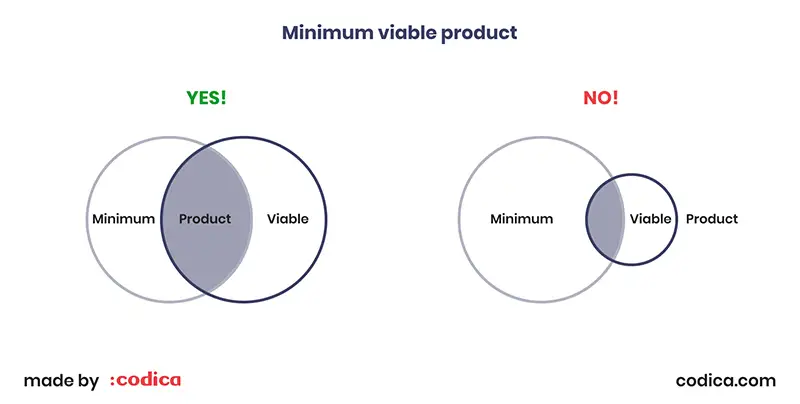Click here to get this post in PDF
When it comes to custom software development, a minimum viable product has become a popular concept these days. The MVP software development proved beneficial for entrepreneurs who want to test their business idea without investing too much money. The success stories of Uber or Zappos only proves this fact.
Before we proceed to the key advantages of an MVP, let’s start with the definition of the term in question.
What is a Minimum Viable Product?
According to Wikipedia, an MVP can be seen as a product that has enough features to meet the demands of early adopters. It is launched to get the feedback required for further improvement. This concept originates from Lean Startup. This methodology stresses the importance of learning when building a new software solution.
Eric Rise, an entrepreneur and author of the Lean Startup methodology offers another definition of the term MVP. He sees it as a version of a new product that helps get the maximum amount of validated learning about users with minimal effort. Validated learning here is customers’ feedback as for the solution you offer and their decision to purchase it or not.
Minimum Viable Product is a primary version of a solution that addresses at least one potential user’s pain point. With an MVP, you can quickly test the waters.
When you come up with the idea of a product or service, you cannot know for sure whether it’s worth any investment. And here’s when an MVP saves the day. With this approach, you avoid wasting time and money on sophisticated features. Instead, you create a basic product, which can further be enhanced.
It is worth noting that the term product here serves as a general part of the definition. It can be applied to an enterprise or an approach to testing a business hypothesis.
We have clarified the meaning of the MVP term. Now let’s discuss how this concept can help you create a successful full-featured project.
5 advantages of building an MVP for a startup
1. Cost reduction and risk minimization
Setting about building a custom software solution, you should bear in mind that it will take a lot of money, time, and effort to launch a large-scale web product. Besides, the whole venture may turn out a complete disaster if your business idea does not work.
In this regard, a Minimum Viable Product will help you save costs and lower risks that come with custom software development.
When it comes to the MVP, you will need to implement only the very basic functionality. Consequently, the development team will need less time to complete the project. As a result, their services will become more affordable.
It is not surprising that many software companies such as Instagram, Facebook, Snapchat, Airbnb, and Spotify started as MVPs.
When they saw the demand for their services, these brands gradually expanded their offerings by adding new features. This way, they avoided common mistakes a lot of startups make in their early days. For example, businesses refused to spend too much time and money on building extensive functionality.
2. Clear focus and flexibility
The MVP approach helps you focus on your unique value proposition. It becomes easier for you to identify the exact pain point you are going to address with your product or service. Consequently, you will choose the right functionality to be implemented in the first place.
Another benefit of an MVP lies in the ability to create a clear interface. You start with the simple functionality users cannot do without. This way, you make sure that your software product is intuitive and easy to use.
In addition, a minimum viable product allows you to test each feature separately without the need to keep an eye on the whole project.
Speaking about the MVP approach, we cannot but mention the flexibility regarding updates and new functions. They depend solely on your customer’s needs and wants. Besides, since you introduce new functions over some time, there will always be new technologies and tools. You can benefit from using them by making your product competitive.
3. Establishing connection with potential customers
The time has come to discuss the main aim of building an MVP, which is getting feedback from the first users. They express their honest, unbiased opinion regarding your product. Based on their reaction, you will know what features you will need to add, remove, or modify. This way, they will help you build a 100% customer-oriented solution that meets the specific needs of your target audience.
Besides, if pioneer users like your solution, they will spread the word about it and create a strong community. Thus, you increase your chances to expand customer base from its early inception.
4. Gaining financial aid
You should have a feasible business idea if you expect to get the required funding. In other words, you need to convince the investors that there is a demand for your product or service. In this case, they will be more eager to give you money for further product development.
The MVP approach allows you to launch a solution quickly and prepare for customers’ feedback. If it is favored, you can demonstrate your MVP to investors with ease, convinced of the relevance of your offering.
5. Quick launch
It has been said earlier that you can build an MVP within a short time-frame. All it takes is to choose the primary functionality that will address a specific issue and put it on the market.
Why is fast launch so important? First, you will be able to scale your business properly. Besides, you get the opportunity to try out your marketing strategies and sales channels.
Also, a minimum viable product helps you avoid procrastination with the release dates. Constant postponement can have a negative impact on your business. For example, one could start building sophisticated and completely unnecessary functionality. Alternatively, you may spend much time and money on fixing numerous bugs. Besides, there are chances that some company will launch a similar application before you do.
Advantages and Disadvantages of custom software development
Final thoughts
We can say for sure that the MVP development proved beneficial for businesses both in the long and short term. It allows you to identify your unique value proposition and reduce the cost of custom software development. Also, with its help, you can reduce risks and get the required funding. Finally, it allows launching the product quickly and receiving feedback from early adopters.
About the Author
CEO @ Codica. Software Entrepreneur with 15+ years of experience. Focused on the lean startup approach. I write about startups, marketplaces and SaaS products, and custom software development.


